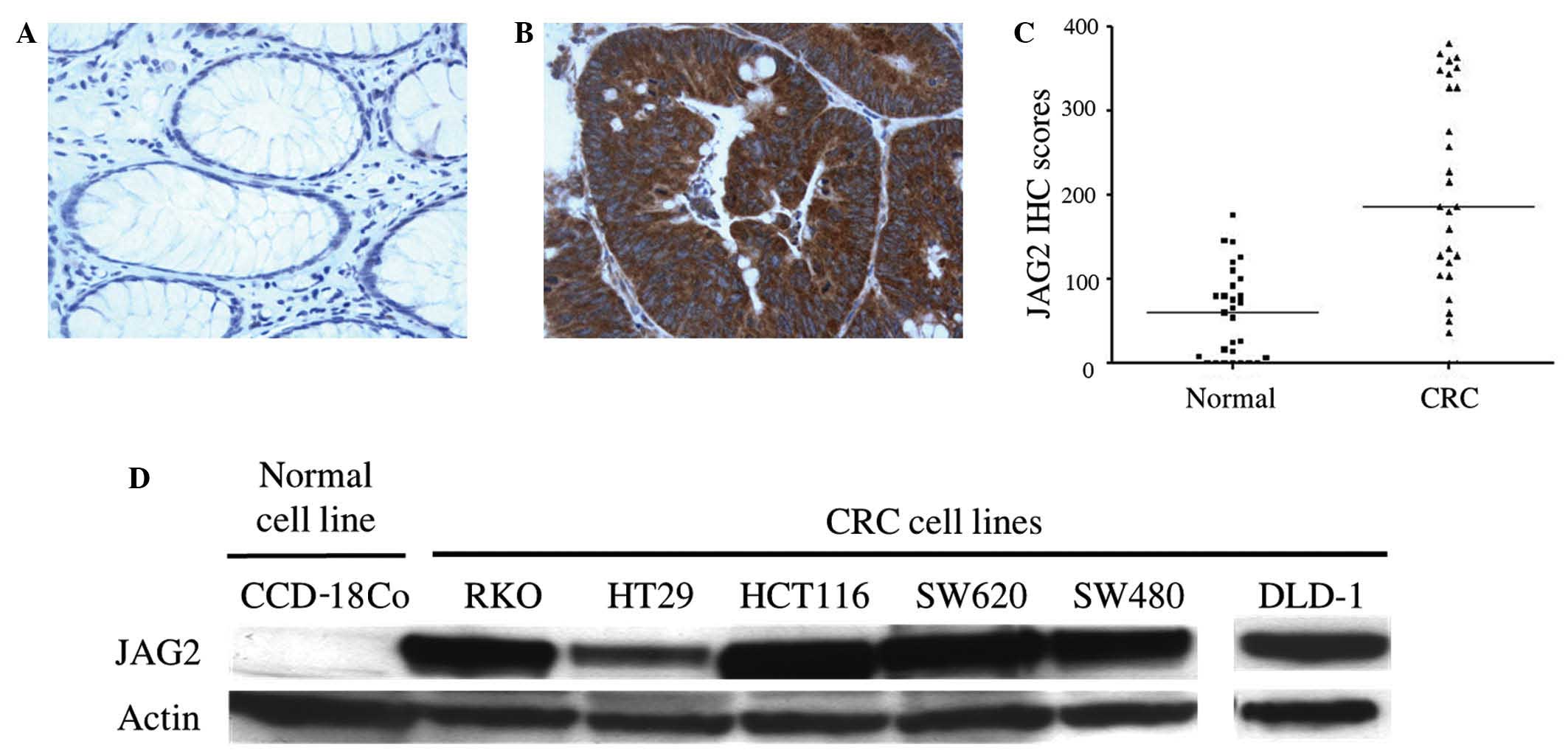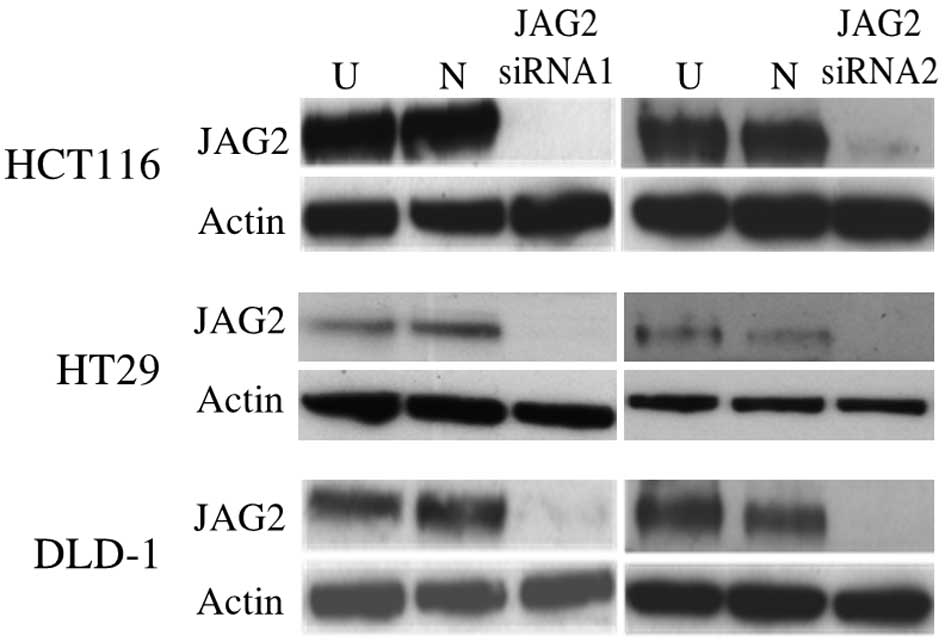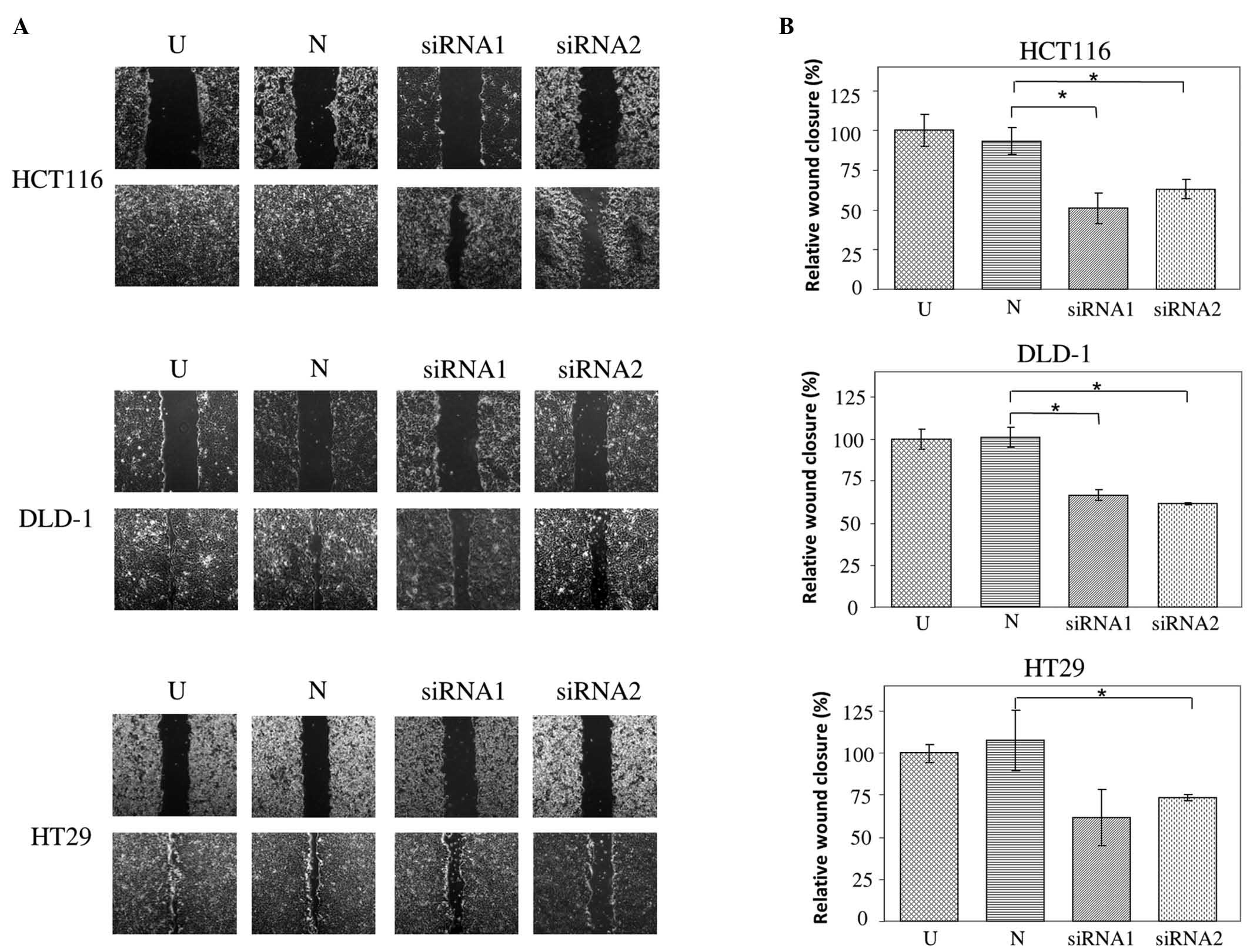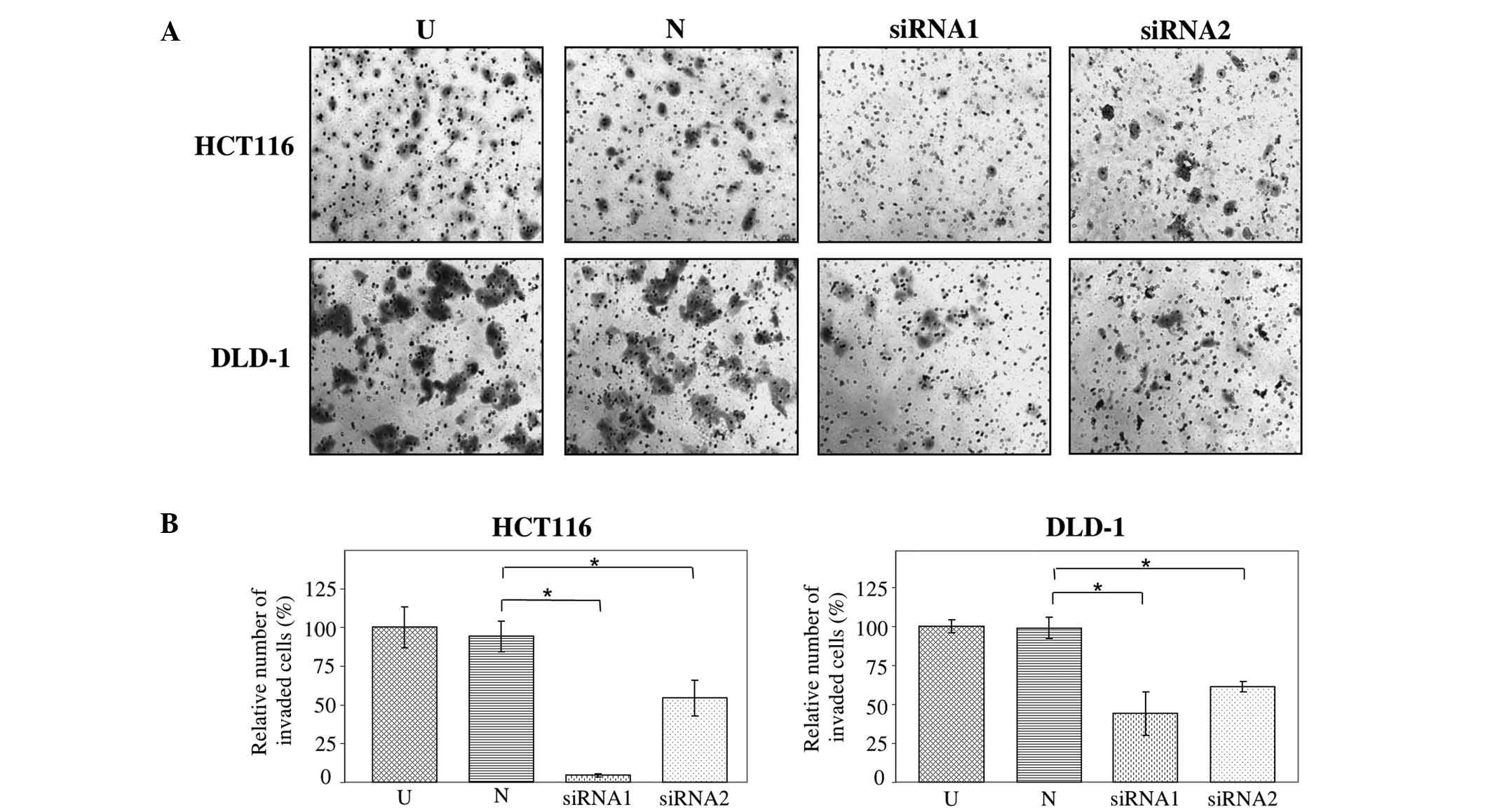Jagged 2 silencing inhibits motility and invasiveness of colorectal cancer cell lines
- Authors:
- Published online on: October 26, 2016 https://doi.org/10.3892/ol.2016.5321
- Pages: 5193-5198
Abstract
Introduction
Colorectal cancer (CRC) is the third most common cancer in males and the second in females, respectively, with >1.4 million newly diagnosed cases and 693,933 mortalities estimated to have occurred in 2012, accounting for 8.5% of all cancer mortalities, thus making CRC the fourth most common cause of mortality from cancer worldwide (1). Approximately 20% of CRC patients present with metastases at the time of diagnosis, and ~50% of the patients without metastases at presentation exhibit distant metastases within 3 years of diagnosis (2). For patients with unresectable metastatic CRC, prognosis is poor, with a 5-year survival of <10%; however, a marked benefit in median overall survival may be achieved with palliative systemic therapy (3). Significant advances in systemic treatment for metastatic CRC, including targeted therapies, have improved survival; however, even with combination of target agents and chemotherapy, the median survival of CRC patients is only ~29 months (4). A better understanding of the factors that lead to tumor progression and metastasis is urgently required for the development of novel strategies for CRC treatment.
The Notch pathway is highly conserved and functions in numerous biological processes, including cell differentiation, proliferation and death (5–7). Mammals have four types of membrane-bound Notch receptors (Notch 1–4) and five types of membrane bound ligands (Jagged 1–2, and Delta-like 1, 3 and 4) (2). Upon ligand binding, Notch receptors undergo proteolytic cleavage to release the Notch intracellular domain, which enters the nucleus and associates with DNA binding proteins to act as a transcriptional factor for the regulation of gene transcription.
Notch pathway signaling is activated in several types of cancer, including CRC, T-cell acute lymphoblastic leukemia (T-ALL) (8) and breast cancer (9). Among the Notch ligands, upregulation of JAG2 expression has been shown to be significantly associated with vascular development, metastasis-free and overall survival in breast cancer patients (10,11). In ovarian carcinoma, elevated JAG2 levels are reported to be associated with lymph node and distant metastases (12). These findings are indicative of a pivotal role for JAG2 expression during cancer progression. However, there is extremely limited information available with regard to the expression pattern and functional role of JAG2 protein in human CRC. Therefore, the present study aimed to investigate the expression and function of JAG2 in human CRC. JAG2 protein expression was assessed in 40 cases of human CRC tissues and 7 human colon cell lines, while its functions were studied by RNA interference in 3 CRC cell lines. The effects of JAG2 silencing on the cellular functions of CRC cell lines were assessed by wound healing assay, Matrigel invasion assay and cell growth assay.
Materials and methods
Cell lines and tissues
The human CRC cell lines SW480, SW620, HCT116, DLD-1, HT29 and RKO, and a normal colon cell line, CCD-18Co, were purchased from the American Type Culture Collection (ATCC; Manassas, VA, USA) and cultured in RPMI-1640 medium supplemented with 10% fetal bovine serum (Thermo Fisher Scientific, Inc., Waltham, MA, USA) at 37°C in a humidified incubator with 5% CO2.
Formalin-fixed, paraffin-embedded colorectal carcinoma specimens were obtained from the Department of Pathology of Queen Elizabeth Hospital (Hong Kong SAR, China). Approval from an institutional ethics review board and informed consent from all participants were obtained.
Immunohistochemical (IHC) staining
Sections (4-µm thick) were de-waxed, rehydrated and stained for JAG2 protein expression using a rabbit anti-human JAG2 polyclonal antibody (#06-1097; EMD Millipore, Billerica, MA, USA; dilution, 1:500) for 92 min at room temperature in a Ventana BenchMark XT processor (Ventana Medical Systems, Tucson, AZ, USA) and counterstained with hematoxylin. The negative control included sections incubated with antibody dilution buffer (#950-300; Ventana Medical Systems) without primary antibody. Slides were visualized using the ultraView Universal DAB Detection kit (#760-500; Ventana Medical Systems). Two independent observers who were blinded to the patients' clinical information assessed the scoring of positive staining signals. In each patient tissue specimen, 5 fields at ×400 magnification were evaluated. The scoring of staining intensity was as follows: 0, negative; 1, weak; 2, moderate; 3, strong; and 4, very strong. An IHC score ranging from 0 to 400 was obtained by multiplying the percentage of the positive cells (0–100%) by the staining intensity (score 0–4) (13).
Western blot
Cells were lysed in buffer containing sodium dodecyl sulfate, protease inhibitors and phosphatase inhibitors (Roche Diagnostics, Basel, Switzerland). Equal amounts of protein lysates were gel-separated and transferred onto nitrocellulose membranes (Bio-Rad Laboratories, Inc., Hercules, CA, USA). Blocking was conducted in a buffer containing 5% non-fat milk and 0.05% Tween 20 in Tris-buffered saline for 1 h at room temperature. Primary antibodies were incubated at 4°C overnight, while secondary antibodies were incubated for 1 h at room temperature. Protein bands were detected with SuperSignal® West Pico Chemiluminescent Substrate (Thermo Fisher Scientific, Inc.) and Hyperfilm ECL film (GE Healthcare, Uppsala, Sweden). The following antibodies were used: Rabbit anti-human JAG2 monoclonal antibody (#2210; Cell Signaling Technology, Danvers, MA, USA; dilution, 1:1,000); mouse anti-actin monoclonal antibody (#ab3280; Abcam, Cambridge, UK; dilution, 1:50,000); horseradish peroxidase (HRP)-conjugated goat anti-mouse IgG polyclonal secondary antibody (#170-6516; Bio-Rad Laboratories, Inc.; dilution, 1:100,000); HRP-conjugated goat anti-rabbit IgG polyclonal secondary antibody (#81-6120; Thermo Fisher Scientific, Inc.; dilution, 1:100,000).
siRNA transfection
Cells were transfected with 25 nM siRNA using Invitrogen Lipofectamine 2000 (Thermo Fisher Scientific, Inc.). The siRNAs used included ON-TARGETplus Human JAG2 siRNA (GE Healthcare Dharmacon, Inc., Lafayette, CO, USA) (siRNA1), JAG2 siRNA (#s7645; Thermo Fisher Scientific, Inc.) (siRNA2) and Silencer Select Negative Control No. 1 siRNA (Thermo Fisher Scientific, Inc.). An untransfected control was created by replacing siRNAs with Opti-MEM Reduced Serum Medium (Thermo Fisher Scientific, Inc.).
Cell proliferation assay
At 72 h post transfection, 10 µl of MTS reagent [3-(4,5-dimethylthiazol-2-yl)-5-(3-carboxymethoxyphenyl)-2-(4-sulfophenyl)-2H-tetrazolium; Promega, WI, USA] was added to 100 ml of fresh culture medium in each well of a 96-well plate and incubated for 3 h at 37°C. Optical density at 490 nm was measured using the VICTOR3 Multilabel Plate Reader 1420 (PerkinElmer, Inc., Waltham, MA, USA). The surviving percentage of cells was calculated by the following formula: Cell proliferation % = (OD test sample/ODcontrol sample) × 100%
The control sample reading was obtained from wells containing untransfected cells. The reading was taken as the mean of four wells, and the results were expressed as mean ± standard error.
Monolayer scratch wound healing assay
siRNA-transfected cells were seeded into culture plates, allowed to form a confluent monolayer and serum starved overnight. Wounds were created by scratching with sterile pipette tips. Fresh culture medium was replenished every 24 h (serum-free culture medium for DLD-1 and HT29; culture medium supplemented with 1% serum for HCT116 cells). Photographs were taken under a microscope and the cell-free area was measured using ImageJ analysis software version 1.43 (http://rsb.info.nih.gov/ij). Wound closure was calculated by the following equation and expressed as a percentage relative to the untreated control, which was taken to be 100% (14):
Woundclosure%=[(cellfreearea)0–(cellfreearea)t]experiment[(cellfreearea)0–(cellfreearea)t]control×100%‘Experiment’ represents experimental samples and ‘control’ represents untreated control samples. The results were expressed as the mean ± standard error of the mean (SEM) and plotted in bar charts. All experiments were performed in triplicate.
Matrigel invasion assay
Cells were harvested at 48 h post transfection and transferred to the upper chamber of BioCoat Matrigel Invasion Chambers (BD Biosciences, San Jose, CA, USA) in serum-free medium. Culture medium with 10% fetal bovine serum was added to the lower compartment as a chemoattractant. Following a 48-h incubation at 37°C in a humidified incubator with 5% CO2, cells remaining in the upper chamber were removed by cotton swabs and cells that had invaded to the bottom surface of the membrane were fixed in methanol and stained with 0.1% Toluidine Blue O (Sigma-Aldrich). The numbers of invaded cells on the bottom surface of the membrane were counted, expressed as mean ± SEM and plotted in the bar charts. All experiments were repeated three times.
Statistical analysis
The differences in IHC scores between tumor tissues and normal colorectal epithelia were analyzed by Wilcoxon signed rank test. For cell proliferation, migration and invasion studies, statistical significance was analyzed by an unpaired t-test. P<0.05 as considered to indicate a statistically significant difference. All calculations were performed using SPSS software (version 16.0; SPSS Inc., Chicago, IL, USA).
Results
JAG2 is overexpressed in CRC tissues and cell lines
IHC staining was used to assess the level and pattern of JAG2 protein expression in tissues from 40 cases of human CRC. JAG2 expression was detected in 38/40 CRC cases (95.0%) and in 5/40 surrounding normal tissues (12.5%), with a predominantly membrane/cytoplasmic localization (Fig. 1A and B). A 3.1-fold increase in median IHC score was observed in tumor regions compared to adjacent normal areas (P<0.0001) (Fig. 1C), indicating JAG2 overexpression in CRC tissues. In addition, JAG2 expression was detected by western blot in all CRC cell lines tested, including RKO, HT29, HCT116, SW620, SW480 and DLD-1, but not in the non-malignant colon cell line, CCD-18Co (Fig. 1D). Together, these findings indicate that JAG2 protein is frequently overexpressed in CRC cells compared to non-malignant colon cells.
JAG2 silencing inhibits migration of CRC cell lines
To study the functions of JAG2 in CRC, RNA interference was used to knockdown its expression in three CRC cell lines: HCT116, DLD-1 and HT29. Two different siRNAs were used to provide support to the specificity of the observed effects. The functional consequences of JAG2 silencing on cell migration, invasion and proliferation were then assessed by monolayer scratch wound healing, Matrigel invasion and cell growth assays, respectively.
JAG2 knockdown was confirmed at the protein level using western blot at 48 h post transfection (Fig. 2). Wound healing assays reveal impaired wound closure of cells transfected with either of the JAG2 siRNAs in HCT116, DLD-1 and HT29 cell lines compared to those transfected with negative control siRNA (HCT116, P=0.015 for siRNA1 and P=0.018 for siRNA2; DLD-1, P=0.005 for siRNA1 and P=0.002 for siRNA2; and HT29, P=0.082 for siRNA1 and P=0.019 for siRNA2) (Fig. 3A and B). This finding indicates that JAG2 silencing can inhibit the motility of the CRC cell lines tested.
JAG2 silencing inhibits the invasiveness of CRC cell lines
The effect of JAG2 silencing on cell invasion in HCT116 and DLD-1 cells was assessed using Matrigel invasion assays. HT29 cells do not invade through Matrigel and were thus excluded from this analysis. The findings demonstrate that the invasive capability of JAG2-silenced HCT116 and DLD-1 cells decreased significantly relative to cells transfected with negative control siRNA (HCT116, P=0.009 for siRNA1 and P=0.021 for siRNA2; and DLD-1, P=0.049 for siRNA1 and P=0.013 for siRNA2) (Fig. 4A and B). This result indicates that JAG2 silencing is inhibitory for invasiveness of CRC cell lines and supports a pro-invasive role for JAG2 expression in CRC cells.
JAG2 silencing does not significantly affect cell proliferation in CRC cell lines
The effect of JAG2 knockdown on cell proliferation was investigated. No significant difference in the number of HCT116, DLD-1 or HT29 cells was detected at 72 h post JAG2 knockdown compared with negative controls (HCT116, P=0.756 for siRNA1 and P=0.196 for siRNA2; DLD-1, P=0.265 for siRNA1 and P=0.092 for siRNA2; and HT29, P=0.583 for siRNA1 and P=0.862 for siRNA2) (Fig. 5), indicating that JAG2 knockdown does not significantly affect cell proliferation in all three CRC cell lines tested. Combined with the previously mentioned findings, this result indicates that JAG2 knockdown inhibits motility and invasiveness of CRC cell lines independently of mechanisms affecting cell proliferation.
Discussion
Previous studies have indicated that Notch signaling is upregulated in CRC (15–18). However, data regarding the expression of JAG2 protein in CRC tissues is scarce. The current study provides insight on this topic by demonstrating that JAG2 expression is detected in up to 95% of CRC cases (38/40 patients) and is 3-fold overexpressed in cancerous tissues compared with surrounding non-tumorous tissues. Furthermore, JAG2 expression was detected in all six of the CRC cell lines tested, but not in a normal colon epithelial cell line. These results are consistent with a previous study that demonstrated upregulated expression of JAG2 mRNA in all 20 CRC cases examined (15). Taken together, the finding that JAG2 is frequently overexpressed in CRC cells is suggestive of a crucial role for this protein in CRC development.
To gain a deeper understanding of the functional significance of JAG2 expression in CRC, the present study used RNA interference to investigate the effects of JAG2 knockdown in three CRC cell lines. The results indicated that JAG2 knockdown reduces migration in HCT116, DLD-1 and HT29 cells. It can also inhibit invasion of HCT116 and DLD-1 CRC cell lines. These effects were not mediated through a reduction in cell proliferation, as cell numbers were not significantly affected relative to cells transfected with negative control siRNA at 72 h post transfection. These findings implicate JAG2 expression in the promotion of CRC metastasis by increasing motility and invasiveness of CRC cells, and indicate that it may be involved in cancer progression rather than initiation.
A similar pro-metastatic function has been reported for JAG2 in other types of cancer. In breast cancer, JAG2 expression was found to promote metastasis and was significantly associated with overall and metastasis-free survival of breast cancer patients (11,19). Likewise, JAG2 was found to be capable of inducing the metastasis of lung adenocarcinoma cells in mice (20). These findings provide support to the hypothesis that JAG2 functions to promote metastasis in multiple cancer types. It would be of interest to investigate whether JAG2 is expressed in circulating tumor cells of CRC patients, as these cells have been demonstrated to be associated with tumor-node-metastasis stage and lymph node status (21,22). In addition, the clinical value of JAG2 as a novel biomarker in CRC warrants further study (23).
In conclusion, the current study has demonstrated that JAG2 is overexpressed in a majority of CRC tissues and is involved in motility and invasiveness, but not proliferation, of CRC cells. Further studies are required to gain a deeper understanding of the precise mechanisms involved.
Acknowledgements
This work was supported by funding from the Chinese University of Hong Kong (Direct Grants 2041697, 4054004 and 4054005).
Glossary
Abbreviations
Abbreviations:
|
CRC |
colorectal cancer |
|
IHC |
immunohistochemical |
|
JAG2 |
Jagged 2 |
|
siRNA |
small interfering RNA |
References
|
Torre LA, Bray F, Siegel RL, Ferlay J, Lortet-Tieulent J and Jemal A: Global cancer statistics, 2012. CA Cancer J Clin. 2:87–108. 2015. View Article : Google Scholar | |
|
McArdle C: ABC of colorectal cancer: Effectiveness of follow up. BMJ. 321:1332–1335. 2000. View Article : Google Scholar : PubMed/NCBI | |
|
Golfinopoulos V, Salanti G, Pavlidis N and Ioannidis JP: Survival and disease-progression benefits with treatment regimens for advanced colorectal cancer: A meta-analysis. Lancet Oncol. 8:898–911. 2007. View Article : Google Scholar : PubMed/NCBI | |
|
Heinemann V, von Weikersthal LF, Decker T, Kiani A, Vehling-Kaiser U, Al-Batran SE, Heintges T, Lerchenmüller C, Kahl C, Seipelt G, et al: FOLFIRI plus cetuximab versus FOLFIRI plus bevacizumab as first-line treatment for patients with metastatic colorectal cancer (FIRE-3): A randomised, open-label, phase 3 trial. Lancet Oncol. 10:1065–1075. 2014. View Article : Google Scholar | |
|
Katoh M and Katoh M: Notch signaling in gastrointestinal tract (review). Int J Oncol. 30:247–251. 2007.PubMed/NCBI | |
|
Liu J, Sato C, Cerletti M and Wagers A: Notch signaling in the regulation of stem cell self-renewal and differentiation. Curr Top Dev Biol. 92:367–409. 2010. View Article : Google Scholar : PubMed/NCBI | |
|
Weng AP and Aster JC: Multiple niches for Notch in cancer: Context is everything. Curr Opin Genet Dev. 14:48–54. 2004. View Article : Google Scholar : PubMed/NCBI | |
|
Weng AP, Ferrando AA, Lee W, Morris JP IV, Silverman LB, Sanchez-Irizarry C, Blacklow SC, Look AT and Aster JC: Activating mutations of NOTCH1 in human T cell acute lymphoblastic leukemia. Science. 306:269–271. 2004. View Article : Google Scholar : PubMed/NCBI | |
|
Reedijk M, Odorcic S, Chang L, Zhang H, Miller N, McCready DR, Lockwood G and Egan SE: High-level coexpression of JAG1 and NOTCH1 is observed in human breast cancer and is associated with poor overall survival. Cancer Res. 65:8530–8537. 2005. View Article : Google Scholar : PubMed/NCBI | |
|
Pietras A, von Stedingk K, Lindgren D, Påhlman S and Axelson H: JAG2 induction in hypoxic tumor cells alters Notch signaling and enhances endothelial cell tube formation. Mol Cancer Res. 9:626–636. 2011. View Article : Google Scholar : PubMed/NCBI | |
|
Xing F, Okuda H, Watabe M, Kobayashi A, Pai SK, Liu W, Pandey PR, Fukuda K, Hirota S, Sugai T, et al: Hypoxia-induced Jagged2 promotes breast cancer metastasis and self-renewal of cancer stem-like cells. Oncogene. 30:4075–4086. 2011. View Article : Google Scholar : PubMed/NCBI | |
|
Jung SG, Kwon YD, Song JA, Back MJ, Lee SY, Lee C, Hwang YY and An HJ: Prognostic significance of Notch 3 gene expression in ovarian serous carcinoma. Cancer Sci. 101:1977–1983. 2010. View Article : Google Scholar : PubMed/NCBI | |
|
Wong SC, Lo SF, Lee KC, Yam JW, Chan JK and Hsiao WL Wendy: Expression of frizzled-related protein and Wnt-signalling molecules in invasive human breast tumours. J Pathol. 196:145–153. 2002. View Article : Google Scholar : PubMed/NCBI | |
|
McLane MA, Zhang X, Tian J, Zelinskas C, Srivastava A, Hensley B and Paquette-Straub C: Scratching below the surface: Wound healing and alanine mutagenesis provide unique insights into interactions between eristostatin, platelets and melanoma cells. Pathophysiol Haemost Thromb. 34:164–168. 2005. View Article : Google Scholar : PubMed/NCBI | |
|
Reedijk M, Odorcic S, Zhang H, Chetty R, Tennert C, Dickson BC, Lockwood G, Gallinger S and Egan SE: Activation of Notch signaling in human colon adenocarcinoma. Int J Oncol. 33:1223–1229. 2008.PubMed/NCBI | |
|
Meng RD, Shelton CC, Li YM, Chetty R, Tennert C, Dickson BC, Lockwood G, Gallinger S and Egan SE: gamma-Secretase inhibitors abrogate oxaliplatin-induced activation of the Notch-1 signaling pathway in colon cancer cells resulting in enhanced chemosensitivity. Cancer Res. 69:573–582. 2009. View Article : Google Scholar : PubMed/NCBI | |
|
Peignon G, Durand A, Cacheux W, Ayrault O, Terris B, Laurent-Puig P, Shroyer NF, Van Seuningen I, Honjo T, Perret C and Romagnolo B: Complex interplay between β-catenin signalling and Notch effectors in intestinal tumorigenesis. Gut. 60:166–176. 2011. View Article : Google Scholar : PubMed/NCBI | |
|
Serafin V, Persano L, Moserle L, Esposito G, Ghisi M, Curtarello M, Bonanno L, Masiero M, Ribatti D, Stürzl M, et al: Notch3 signalling promotes tumour growth in colorectal cancer. J Pathol. 224:448–460. 2011. View Article : Google Scholar : PubMed/NCBI | |
|
Nam DH, Jeon HM, Kim S, Kim MH, Lee YJ, Lee MS, Kim H, Joo KM, Lee DS, Price JE, et al: Activation of notch signaling in a xenograft model of brain metastasis. Clin Cancer Res. 14:4059–4066. 2008. View Article : Google Scholar : PubMed/NCBI | |
|
Yang Y, Ahn YH, Gibbons DL, Zang Y, Lin W, Thilaganathan N, Alvarez CA, Moreira DC, Creighton CJ, Gregory PA, et al: The Notch ligand Jagged2 promotes lung adenocarcinoma metastasis through a miR-200-dependent pathway in mice. J Clin Invest. 121:1373–1385. 2011. View Article : Google Scholar : PubMed/NCBI | |
|
Wong SC, Chan CM, Ma BB, Hui EP, Ng SS, Lai PB, Cheung MT, Lo ES, Chan AK, Lam MY, et al: Clinical significance of cytokeratin 20-positive circulating tumor cells detected by a refined immunomagnetic enrichment assay in colorectal cancer patients. Clin Cancer Res. 15:1005–1012. 2009. View Article : Google Scholar : PubMed/NCBI | |
|
Wong SC, Ng SS, Cheung MT, Luk LY, Chan CM, Cheung AH, Lee VH, Lai PB, Ma BB, Hui EP, et al: Clinical significance of CDX2-positive circulating tumour cells in colorectal cancer patients. Br J Cancer. 104:1000–1006. 2011. View Article : Google Scholar : PubMed/NCBI | |
|
Wong SC, Chan CM, Ma BB, Lam MY, Choi GC, Au TC, Chan AS and Chan AT: Advanced proteomic technologies for cancer biomarker discovery. Expert Rev Proteomics. 6:123–134. 2009. View Article : Google Scholar : PubMed/NCBI |














